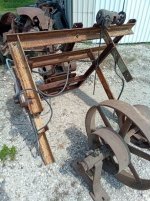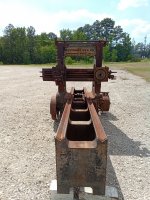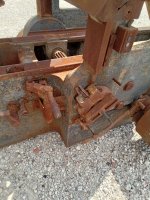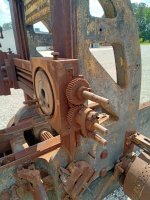M.B. Naegle
Diamond
- Joined
- Feb 7, 2011
- Location
- Conroe, TX USA





Here's the overhead stuff. The framework is of course aftermarket, but as it's held together all with square head bolts, I think it's "old" at any rate. The part of the rack that's white or grey only holds the jack-shaft assembly and the bearings for it appear to be meant to be mounted with the hangers under the shaft (like it sits in the photos). There are also some un-used large square head bolts in the back of the columns that seem to imply that this machine may have come from the factory with the overhead jack-shaft mounted on the machine, not a ceiling mount configuration, and at some point they may have broken the original cast iron brackets, or needed to change where the jack-shaft sat above. I'm not sure if that implies it was an electric machine from the beginning, or perhaps they used to offer shaft driven machines that just had the jack-shaft mounted to the machine (semi-mobile version of the machine). The parts of the frame that hold the motors were all added at a later date, as they were stick-welded together and not painted with the main framing. The little gear head motor was added for operating the power feed and has a little variable-speed controller with it, but I think it'll be one of the first things to go in favor of putting it back to belt drive, as all of the pullies seem to be there to do so. The Jack-shaft has also had some bits sawn off the castings and shaft to operate a now gone clutch. The shaft is bent and will need to be taken apart to straighten or replace anyway, so when that happens I'll look into recreating the clutch function.





 Unfortunately didn't get to get any pictures yet, but they're coming.
Unfortunately didn't get to get any pictures yet, but they're coming.





















